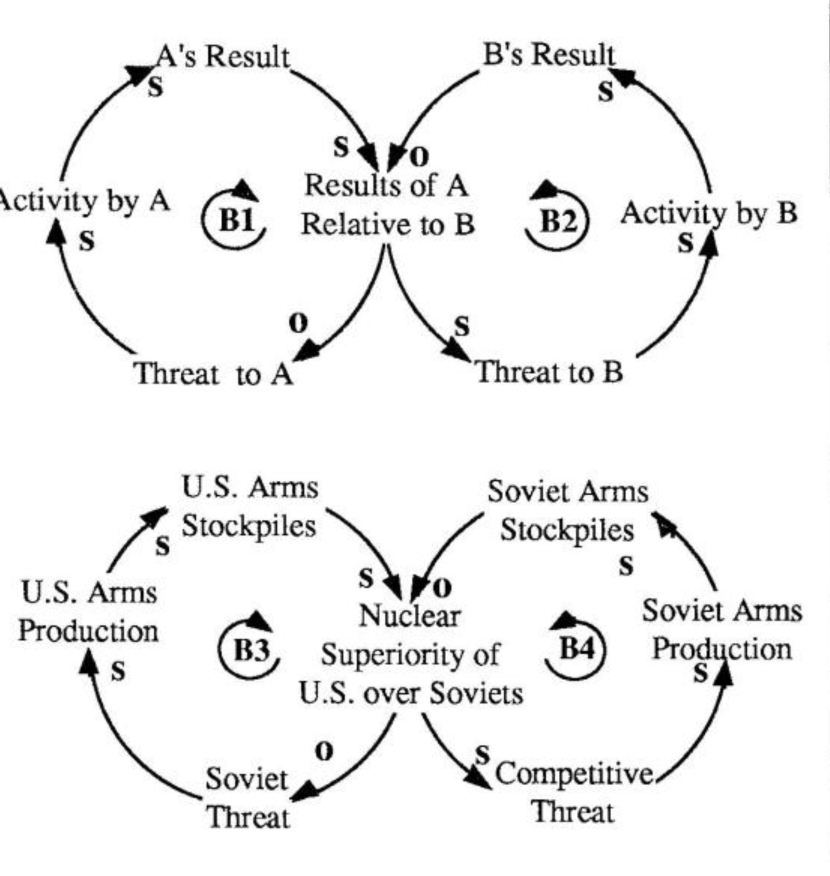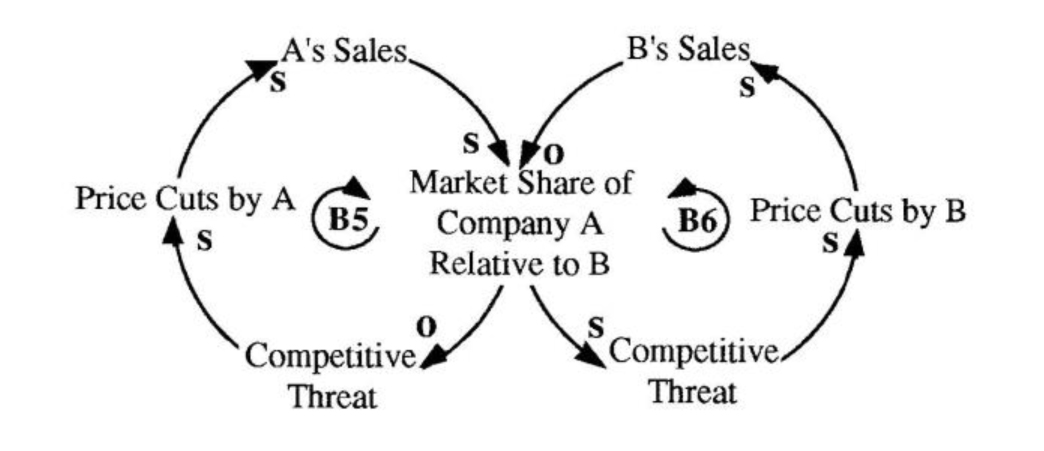Have you ever been caught in a situation where you felt that things were going well beyond what you intended, but you felt powerless to stop it? As a child, perhaps, in the playground at school — a classmate makes a snide comment, and you counter with a sharp retort. The next round of insults gets uglier and louder. You each stick your neck out further and further with every remark. Classmates gather around and egg on the escalation of hostilities. Pretty soon, you arc so far out on a limb that there is little else left to do but succumb to the chanting that has begun all around you — “Fight! Fight! Fight!”
The Dynamics of Insecurity
At the heart of an escalation dynamic are two (or more) parties, each of whom feels threatened by the actions of the other (see “Escalation Archetype” ). Each side attempts to keep things under control by managing its own balancing process. Actions taken by A, for example, improve A’s result relative to B. This decreases A’s feeling of threat, so A eases off its activities (B 1). B, on the other hand, now feels threatened by A’s relative advantage and increases its activities in order to improve its result over A (B2). The interaction of the two parties trying to unilaterally maintain control produces a reinforcing spiral in which nobody feels in control.
In school, a few harsh words can quickly lead to a playground brawl. In a more deadly confrontation, the escalation structure can lead to catastrophic consequences. The Cuban Missile Crisis in October of 1962, for example, caught U.S.. President Kennedy and Soviet Chairman Khrushchev in an escalation structure that led their countries to the brink of nuclear war.
The crisis began with the discovery of offensive nuclear weapons being constructed in Cuba — contrary to repeated public assurances by the Soviet chairman. The U.S. called for complete dismantling and withdrawal of the missiles. The Soviets first denied the existence of any such missiles. Then they acknowledged the missiles but refused to remove them, claiming they were defensive. Kennedy responded by ordering a naval blockade around Cuba to prevent more missiles from being shipped. Tensions were high. The Soviets pressed for accelerated construction of the missiles already in Cuba. The United States massed over 200,000 troops in Florida to prepare for an invasion.
When a United States U2 reconnaissance plane was shot down over Cuba, Kennedy’s advisors unanimously proposed launching a retaliatory strike. But Kennedy stopped short. “It isn’t the first step that concerns me,” he said, “but both sides escalating to the fourth and fifth step. And we won’t go to the sixth because there [will be] no one around to do so.” Had Kennedy not broken the escalation structure at that juncture, the forces unleashed might have been beyond anyone’s control to stop.
Escalation Archetype and Price Wars

De-escalation
The Cuban missile crisis was one incident in a larger dynamic — the Cold War. Although that particular crisis was resolved, it did nothing to defuse the mutual distrust between the two countries, so the ‘arms race continued (see “Arms Race” diagram). The balance of power shifted over time as each side built more arms in response to a perceived threat from the other. Yet, the very act of building arms to “balance” the situation only led to further threat, which strengthened the other side’s “need” for even more arms.
It takes two to have an arms race, but only one to stop it. Unilateral action can break the escalation dynamic by robbing it of its legitimacy. If one side stops building arms, the source of threat diminishes, giving the other side less reason to invest in more arms. The escalation can then run in reverse. A recent newspaper headline, “Gorbachev escalates arms cuts,” shows how the arms race is now being driven rapidly in reverse.
Price Wars

Wars on Many Fronts
Escalation dynamics, because they thrive in a competitive environment, are pervasive in business. The common logic is that whenever your competitor gains, you lose (and vice versa). That logic leads to all kinds of “wars” — price wars, advertising wars, rebate and promotion wars, salary and benefit wars, labor and management wars, divisional wars, marketing vs. manufacturing department wars, and so on.
At the core of each of these wars is a set of relative measures that pits one group against another in a zero-sum game. In a typical price war (see “Price Wars” diagram), company A wants to “buy” market share by cuttings its price. As its sales and market share increase, B’s market share decreases. B retaliates by slashing its prices, generating more sales for B at the expense of A’s sales. In the short run, consumers may benefit from low prices. But in the long term, everyone may lose, since depressed prices mean less ability to invest in new product development, customer service, and overall attractiveness for the next round of competition.
Reversing or stopping such price wars is difficult. As competitors, A and B cannot collude to set prices. Nor is either company likely to stop unilaterally, since in the absence of other distinguishing features, the market usually favors the one with the lower price. In the heat of battle, a company can easily get locked into one competitive variable, such as price, and neglect to emphasize other strengths. Texas Instruments learned that lesson the hard way. Even though Texas Instruments had a superior technical product, it had to write off its entire personal computer business (the 1199/ 4A) as a result of a vicious price war with Commodore.
Insecurity
As the term “threat” suggests, the escalation archetype is about insecurity. In our playground example, the name-calling threatens our reputation and makes us insecure about our identity. The Cuban Missile Crisis and the arms race threatened the national security of both countries. Engaging in a price war reveals each company’s insecurity about its ability to hold on to customers on a basis other than price.
If you find yourself caught in an escalation dynamic, drawing out the archetype can help you gain some perspective. The following questions are useful for identifying escalation structures. With advance knowledge, you can design strategies around them or use them to your advantage:
- Who are the parties whose actions are perceived as threats?
- What is being threatened, and what is the source of that threat?
- What is the relative measure that pits one party against the other — and can you change it?
- What are the significant delays in the system that may distort the true nature of the threat?
- Can you identify a larger goal that will encompass the individual goals?
- What are the deep-rooted assumptions that lie beneath the actions taken in response to the threat?
The description of the escalation archetype is based on the systems archetypes presented in The Fifth Discipline by Peter M. Senge, Doubleday 1990.
